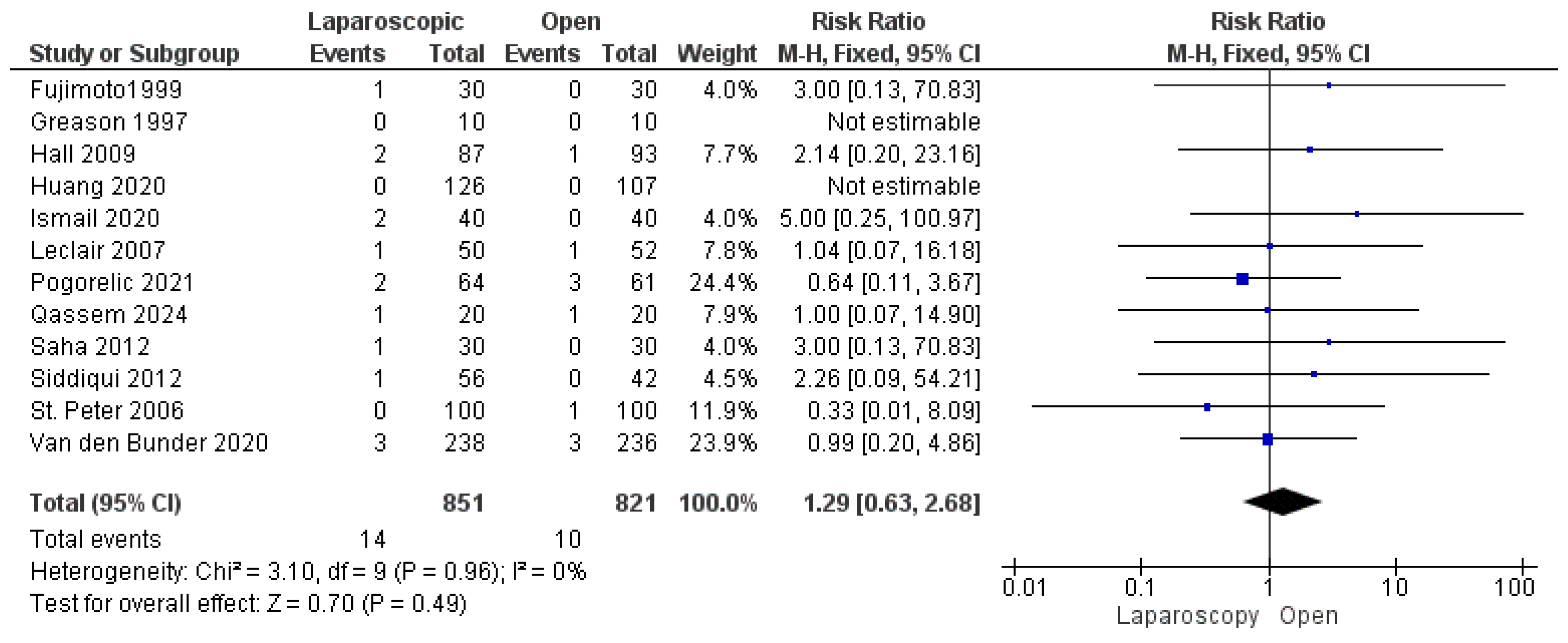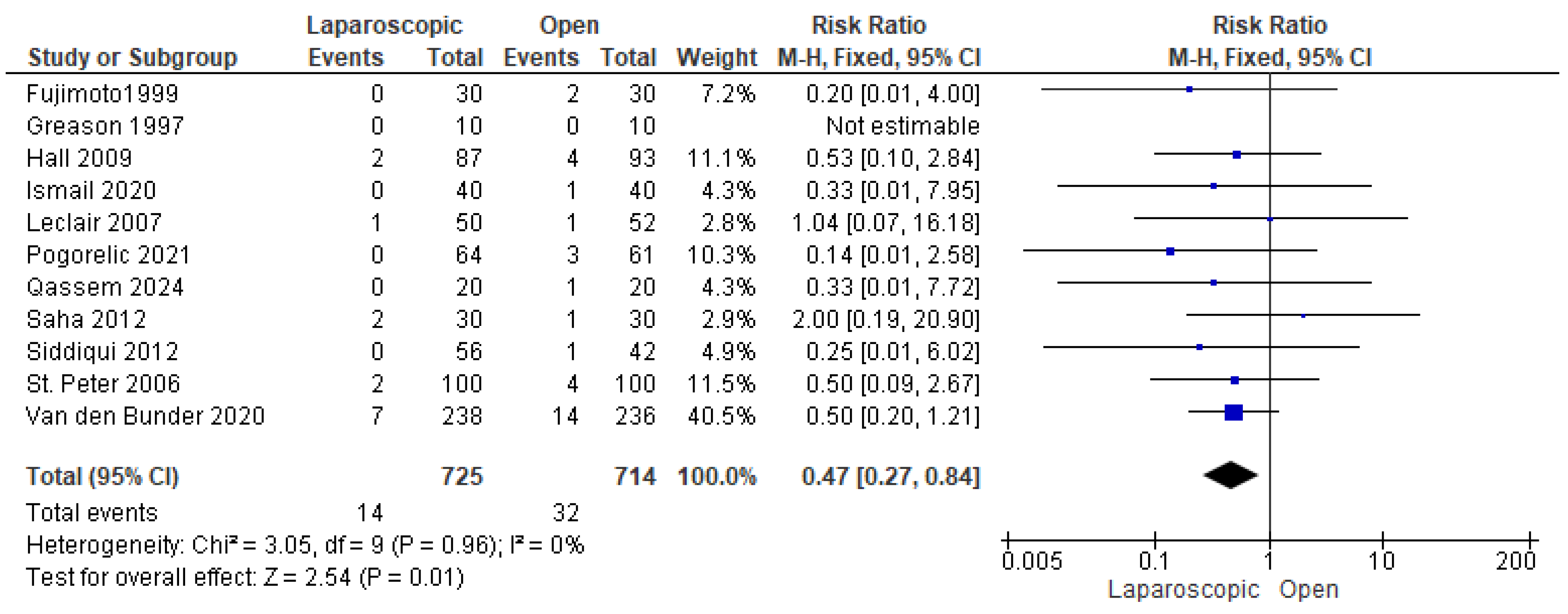Minimally Invasive Versus Open Pyloromyotomy for Infantile Hypertrophic Pyloric Stenosis: Insights from an Updated Systematic Review and Meta-Analysis
Abstract
1. Introduction
2. Methods
2.1. Search and Information Databases
2.2. Selection Criteria and Eligibility Criteria
2.3. Study Population and Design
2.4. Data Extraction
2.5. Quality Assessment
2.6. Qualitative Synthesis
2.7. Statistical Analysis
3. Results
3.1. Summary of the Included Studies
3.2. Risk of Bias Assessment
3.3. Analysis of Outcomes
3.3.1. Operation Time (Min)
3.3.2. Length of Hospital Stay (Hours)
3.3.3. Time to Full Feeding (Hours)
3.3.4. Incomplete Pyloromyotomy
3.3.5. Mucosal Perforation
3.3.6. Wound Infection
3.3.7. Postoperative Vomiting
3.3.8. Postoperative Incisional Hernia
3.3.9. Postoperative Seroma or Hematoma Formation
3.3.10. Need for Reoperation
3.3.11. Conversion to OP
4. Discussion
5. Conclusions
Author Contributions
Funding
Data Availability Statement
Conflicts of Interest
References
- El-Mefleh, N. Recurrent hypertrophic pyloric stenosis: Neonatal age and pyloric canal length as risk factors. Pediatr. Neonatol. 2025, 66, 2–6. [Google Scholar] [CrossRef]
- Aboagye, J.; Goldstein, S.D.; Salazar, J.H.; Papandria, D.; Okoye, M.T.; Al-Omar, K.; Stewart, D.; Lukish, J.; Abdullah, F. Age at presentation of common pediatric surgical conditions: Reexamining dogma. J. Pediatr. Surg. 2014, 49, 995–999. [Google Scholar] [CrossRef] [PubMed]
- Pogorelić, Z.; Čagalj, I.Č.; Žitko, V.; Nevešćanin, A.; Krželj, V. Late-Onset Hypertrophic Pyloric Stenosis in a 14-Weeks-Old Full Term Male Infant. Acta Medica 2019, 62, 82–84. [Google Scholar] [CrossRef] [PubMed]
- Krogh, C. Familial Aggregation and Heritability of Pyloric Stenosis. JAMA 2010, 303, 2393. [Google Scholar] [CrossRef] [PubMed]
- Galea, R.; Said, E. Infantile Hypertrophic Pyloric Stenosis: An Epidemiological Review. Neonatal Netw. 2018, 37, 197–204. [Google Scholar] [CrossRef]
- Krogh, C.; Gortz, S.; Wohlfahrt, J.; Biggar, R.J.; Melbye, M.; Fischer, T.K. Pre- and Perinatal Risk Factors for Pyloric Stenosis and Their Influence on the Male Predominance. Am. J. Epidemiol. 2012, 176, 24–31. [Google Scholar] [CrossRef]
- Applegate, M.S. The Epidemiology of Infantile Hypertrophic Pyloric Stenosis in New York State. Arch. Pediatr. Adolesc. Med. 1995, 149, 1123. [Google Scholar] [CrossRef]
- Cooper, W. Prenatal prescription of macrolide antibiotics and infantile hypertrophic pyloric stenosis. Obstet. Gynecol. 2002, 100, 101–106. [Google Scholar]
- Lammer, E.J.; Edmonds, L.D. Trends in pyloric stenosis incidence, Atlanta, 1968 to 1982. J. Med. Genet. 1987, 24, 482–487. [Google Scholar] [CrossRef]
- Adelstein, P.; Fedrick, J. Pyloric stenosis in the Oxford Record Linkage Study area. J. Med. Genet. 1976, 13, 439–448. [Google Scholar] [CrossRef]
- AlMaramhy, H.H. Is There a Relation Between Pyloric Muscle Thickness and Clinical and Laboratory Data in Infants with Hypertrophic Pyloric Stenosis? Indian J. Surg. 2015, 77, 827–830. [Google Scholar] [CrossRef]
- Quinn, N.; Walls, A.; Milliken, I.; McCullagh, M. Pyloric stenosis—Do males and females present differently? Ulst. Med. J. 2011, 80, 145–147. [Google Scholar]
- Siddiqui, S.; Heidel, R.E.; Angel, C.A.; Kennedy, A.P. Pyloromyotomy: Randomized control trial of laparoscopic vs open technique. J. Pediatr. Surg. 2012, 47, 93–98. [Google Scholar] [CrossRef] [PubMed]
- de Laffolie, J.; Turial, S.; Heckmann, M.; Zimmer, K.P.; Schier, F. Decline in Infantile Hypertrophic Pyloric Stenosis in Germany in 2000–2008. Pediatrics 2012, 129, e901–e906. [Google Scholar] [CrossRef] [PubMed]
- Alain, J.L.; Grousseau, D.; Terrier, G. Extramucosal pyloromyotomy by laparoscopy. Surg. Endosc. 1991, 5, 174–175. [Google Scholar] [CrossRef]
- Leclair, M.D.; Plattner, V.; Mirallie, E.; Lejus, C.; Nguyen, J.M.; Podevin, G.; Heloury, Y. Laparoscopic pyloromyotomy for hypertrophic pyloric stenosis: A prospective, randomized controlled trial. J. Pediatr. Surg. 2007, 42, 692–698. [Google Scholar] [CrossRef]
- Carrington, E.V.; Hall, N.J.; Pacilli, M.; Drake, D.P.; Curry, J.I.; Kiely, E.M.; Coppi, P.D.; Pierro, A.; Eaton, S. Cost-effectiveness of laparoscopic versus open pyloromyotomy. J. Surg. Res. 2012, 178, 315–320. [Google Scholar] [CrossRef]
- Moher, D.; Liberati, A.; Tetzlaff, J.; Altman, D.G.; Altman, D.; Antes, G.; Atkins, D.; Barbour, V.; Barrowman, N.; Berlin, J.A.; et al. Preferred reporting items for systematic reviews and meta-analyses: The PRISMA statement (Chinese edition). J. Chin. Integr. Med. 2009, 7, 889–896. [Google Scholar] [CrossRef]
- Higgins, J.P.; Altman, D.G.; Gøtzsche, P.C.; Jüni, P.; Moher, D.; Oxman, A.D.; Savović, J.; Schulz, K.F.; Weeks, L.; Sterne, J.A. The Cochrane Collaboration’s tool for assessing risk of bias in randomised trials. BMJ 2011, 343, d5928. [Google Scholar] [CrossRef]
- Sterne, J.A.; Hernán, M.A.; Reeves, B.C.; Savović, J.; Berkman, N.D.; Viswanathan, M.; Henry, D.; Altman, D.G.; Ansari, M.T.; Boutron, I.; et al. ROBINS-I: A tool for assessing risk of bias in non-randomised studies of interventions. BMJ 2016, 355, i4919. [Google Scholar] [CrossRef]
- Higgins, J.P.; Green, S. Cochrane Handbook for Systematic Reviews of Interventions: Cochrane Book Series; Wiley: Hoboken, NJ, USA, 2008. [Google Scholar]
- Ismail, I.; Elsherbini, R.; Elsaied, A.; Aly, K.; Sheir, H. Laparoscopic vs. Open Pyloromyotomy in Treatment of Infantile Hypertrophic Pyloric Stenosis. Front. Pediatr. 2020, 8, 426. [Google Scholar] [CrossRef] [PubMed]
- Fujimoto, T.; Lane, G.J.; Segawa, O.; Esaki, S.; Miyano, T. Laparoscopic extramucosal pyloromyotomy versus open pyloromyotomy for infantile hypertrophic pyloric stenosis: Which is better? J. Pediatr. Surg. 1999, 34, 370–372. [Google Scholar] [CrossRef] [PubMed]
- Hall, N.J.; Pacilli, M.; Eaton, S.; Reblock, K.; Gaines, B.A.; Pastor, A.; Langer, J.C.; Koivusalo, A.I.; Pakarinen, M.P.; Stroedter, L.; et al. Recovery after open versus laparoscopic pyloromyotomy for pyloric stenosis: A double-blind multicentre randomised controlled trial. Lancet 2009, 373, 390–398. [Google Scholar] [CrossRef] [PubMed]
- van den Bunder, F.A.I.M.; van Heurn, E.; Derikx, J.P.M. Comparison of laparoscopic and open pyloromyotomy: Concerns for omental herniation at port sites after the laparoscopic approach. Sci. Rep. 2020, 10, 363. [Google Scholar] [CrossRef]
- Greason, K.L.; Allshouse, M.J.; Thompson, W.R.; Rappold, J.F.; Downey, E.C. A prospective, randomized evaluation of laparoscopic versus open pyloromyotomy in the treatment of infantile hypertrophic pyloric stenosis. Pediatr. Endosurgery Innov. Tech. 1997, 1, 175–179. [Google Scholar] [CrossRef]
- Peter, S.D.S.; Holcomb, G.W., III; Calkins, C.M.; Murphy, J.P.; Andrews, W.S.; Sharp, R.J.; Snyder, C.L.; Ostlie, D.J. Open versus laparoscopic pyloromyotomy for pyloric stenosis: A prospective, randomized trial. Ann. Surg. 2006, 244, 363–367. [Google Scholar] [CrossRef]
- Qassem, M.; Dahish, A.; Soliman, M.; Matar, M. Open versus Laparoscopic Pyloromyotomy for Infantile Hypertrophic Pyloric Stenosis. Ain Shams J. Surg. 2024, 17, 29–39. [Google Scholar] [CrossRef]
- Saha, N.; Saha, D.K.; Rahman, M.A.; Aziz, M.A.; Islam, M.K. Laparoscopic versus open pyloromyotomy for infantile hypertropic pyloric stenosis: An early experience. Mymensingh Med. J. 2012, 21, 430–434. [Google Scholar]
- Pogorelić, Z.; Zelić, A.; Jukić, M.; Muñoz, C.M.L. The safety and effectiveness of laparoscopic pyloromyotomy using 3-mm electrocautery hook versus open surgery for treatment of hypertrophic pyloric stenosis in infants. Children 2021, 8, 701. [Google Scholar] [CrossRef]
- Huang, W.H.; Zhang, Q.L.; Chen, L.; Cui, X.; Wang, Y.J.; Zhou, C.M. The safety and effectiveness of laparoscopic versus open surgery for congenital hypertrophic pyloric stenosis in infants. Med. Sci. Monit. 2020, 26, e921555. [Google Scholar] [CrossRef]
- Mahida, J.B.; Asti, L.; Deans, K.J.; Minneci, P.C.; Groner, J.I. Laparoscopic pyloromyotomy decreases postoperative length of stay in children with hypertrophic pyloric stenosis. J. Pediatr. Surg. 2016, 51, 1436–1439. [Google Scholar] [CrossRef] [PubMed]
- Najmaldin, A.; Tan, H. Early experience with laparoscopic pyloromyotomy for infantile hypertrophic pyloric stenosis. J. Pediatr. Surg. 1995, 30, 37–38. [Google Scholar] [CrossRef] [PubMed]
- Kethman, W.C.; Harris, A.H.S.; Hawn, M.T.; Wall, J.K. Trends and surgical outcomes of laparoscopic versus open pyloromyotomy. Surg. Endosc. 2018, 32, 3380–3385. [Google Scholar] [CrossRef] [PubMed]
- Sathya, C.; Wayne, C.; Gotsch, A.; Vincent, J.; Sullivan, K.J.; Nasr, A. Laparoscopic versus open pyloromyotomy in infants: A systematic review and meta-analysis. Pediatr. Surg. Int. 2017, 33, 325–333. [Google Scholar] [CrossRef]
- Staerkle, R.F.; Lunger, F.; Fink, L.; Sasse, T.; Lacher, M.; Elm, E.; Marwan, A.I.; Holland-Cunz, S.; Vuille-dit-Bille, R.N. Open versus laparoscopic pyloromyotomy for pyloric stenosis. Cochrane Database Syst. Rev. 2021, 2021, CD012827. [Google Scholar] [CrossRef]
- Oomen, M.W.N.; Hoekstra, L.T.; Bakx, R.; Heij, H.A. Learning curves for pediatric laparoscopy: How many operations are enough? The Amsterdam experience with laparoscopic pyloromyotomy. Surg. Endosc. 2010, 24, 1829–1833. [Google Scholar] [CrossRef]
- Ostlie, D.J.; Woodall, C.E.; Wade, K.R.; Snyder, C.L.; Gittes, G.K.; Sharp, R.J.; Andrews, W.S.; Murphy, J.P.; Holcomb, G.W. An effective pyloromyotomy length in infants undergoing laparoscopic pyloromyotomy. Surgery 2004, 136, 827–832. [Google Scholar] [CrossRef]
- He, L.; Li, S.; Tang, X. Open versus laparoscopic pyloromyotomy for infantile hypertrophic pyloric stenosis: A systematic review and meta-analysis. Int. J. Clin. Exp. Med. 2022, 15, 129–135. [Google Scholar]
- Costanzo, C.M.; Vinocur, C.; Berman, L. Postoperative outcomes of open versus laparoscopic pyloromyotomy for hypertrophic pyloric stenosis. J. Surg. Res. 2018, 224, 240–244. [Google Scholar] [CrossRef]
- Levy, B.E.; MacDonald, M.; Bontrager, N.; Castle, J.T.; Draus, J.M.; Worhunsky, D.J. Evaluation of the learning curve for laparoscopic pyloromyotomy. Surg. Endosc. 2023, 37, 5101–5108. [Google Scholar] [CrossRef]
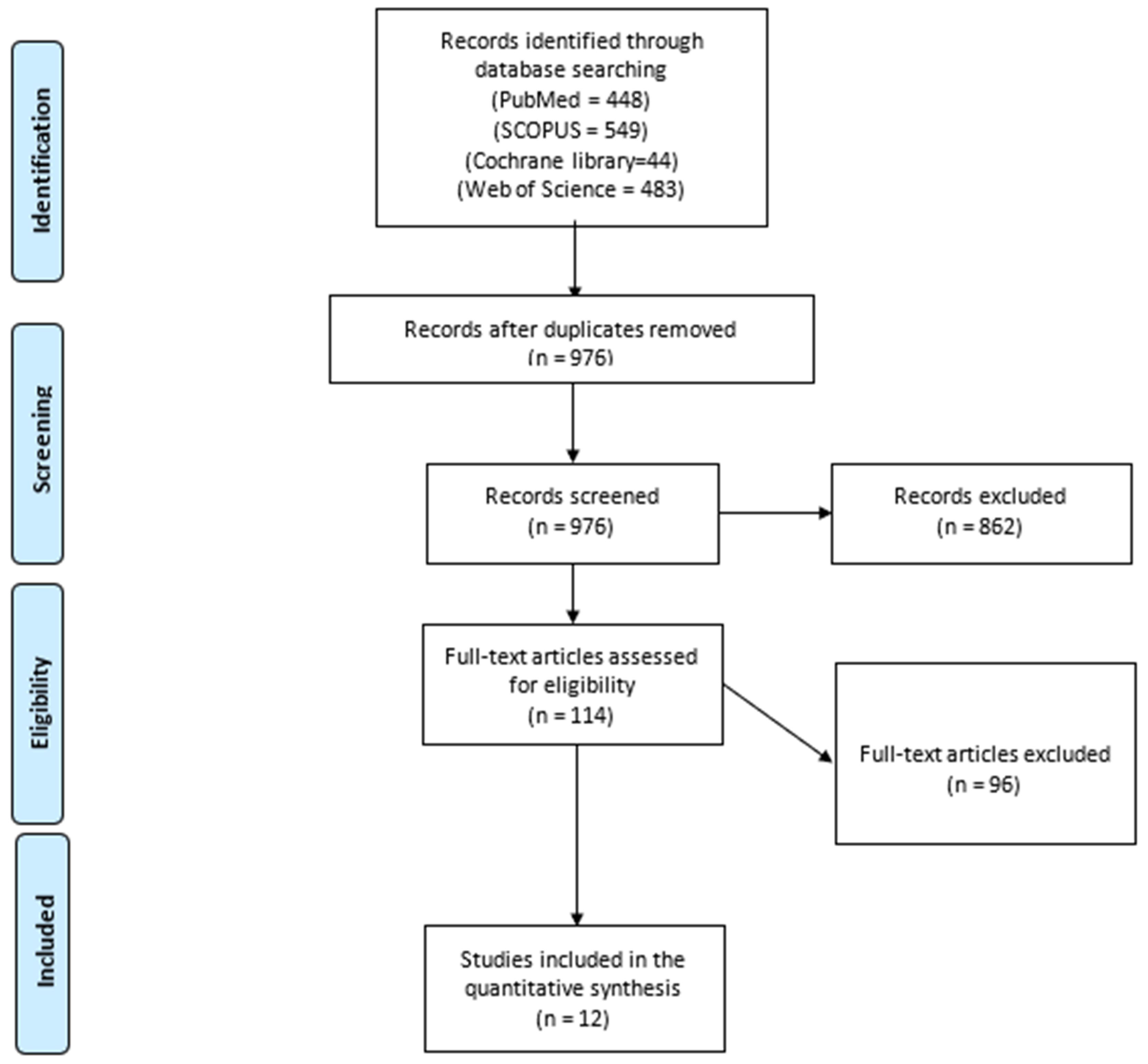
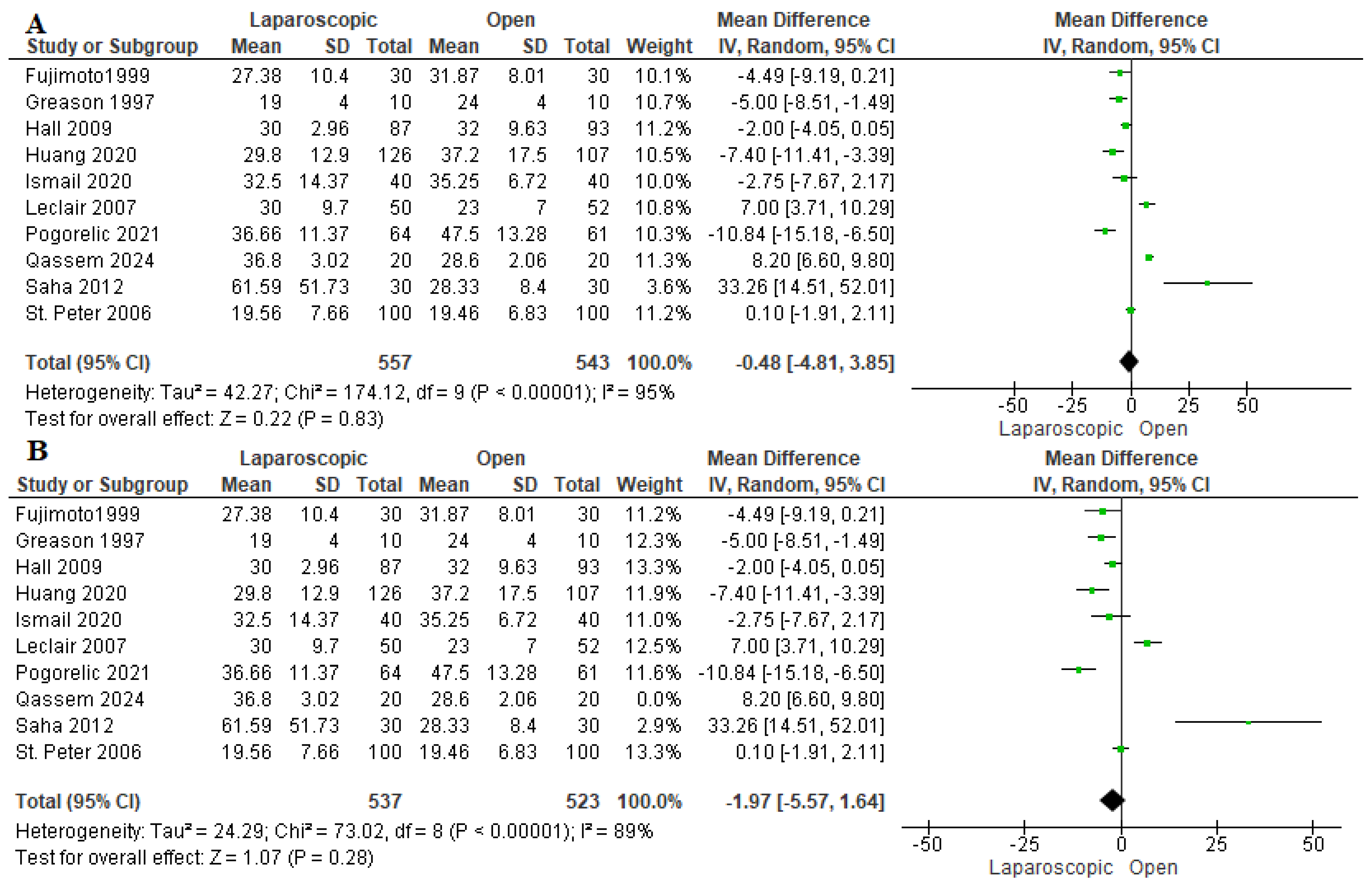
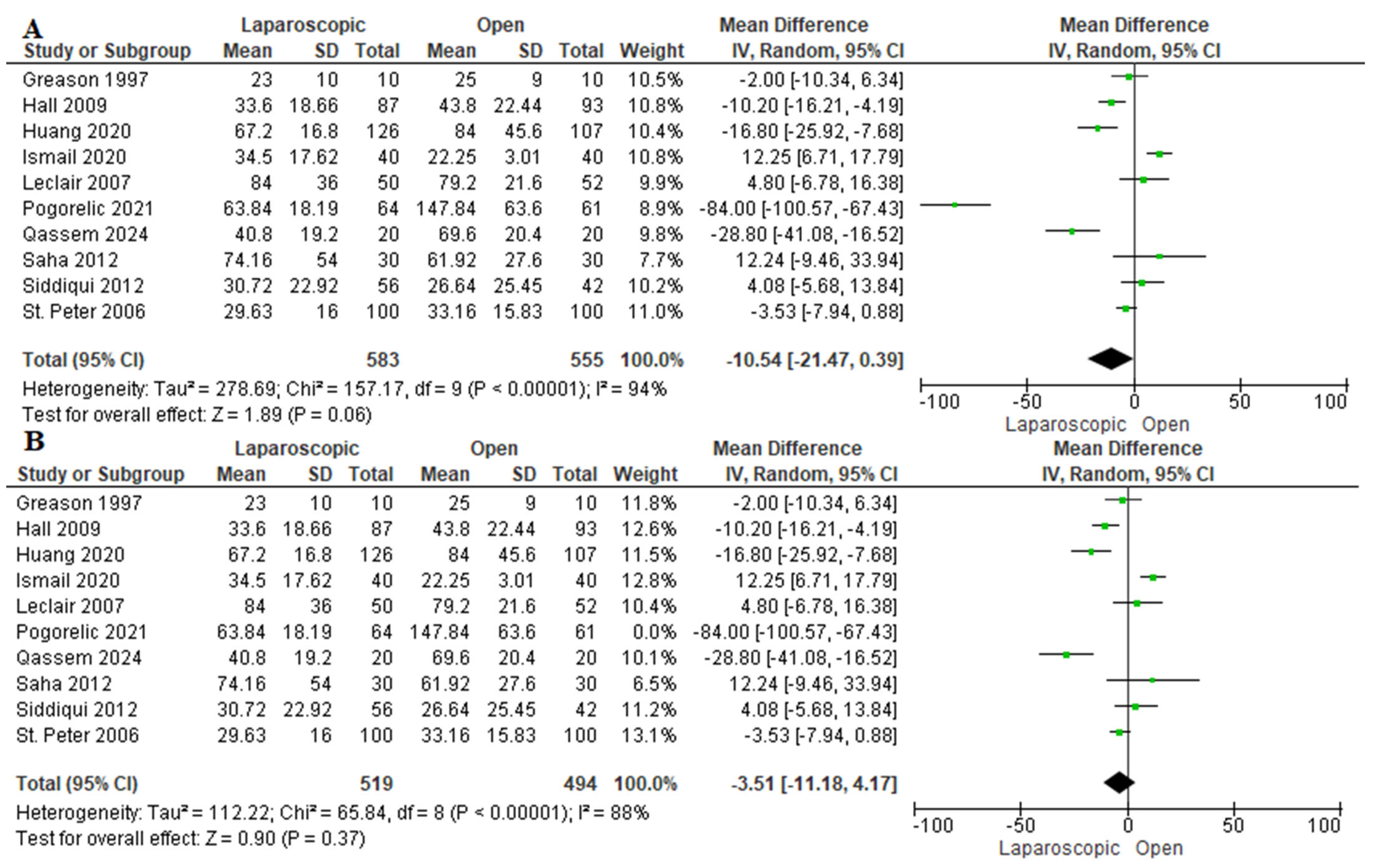
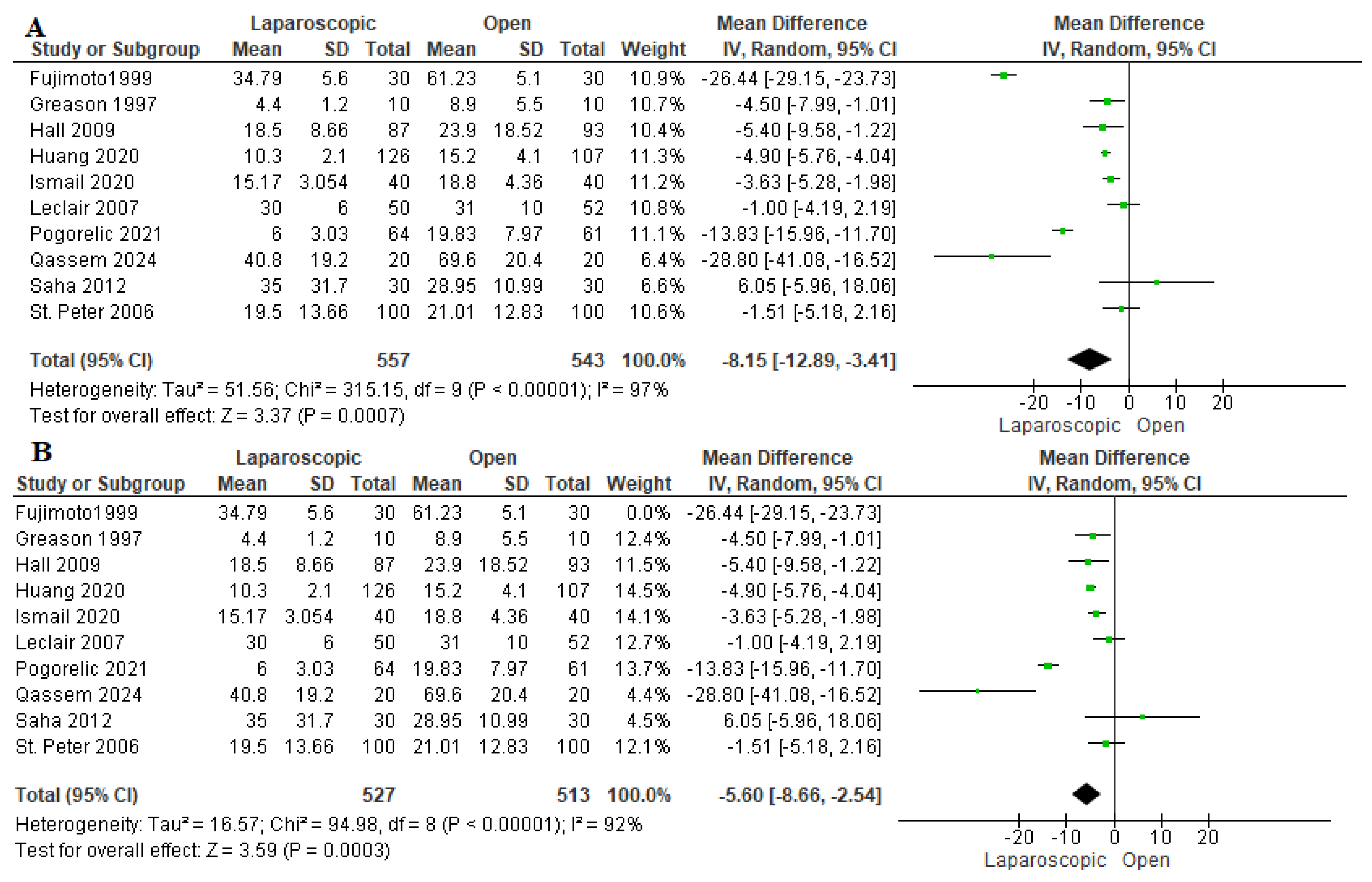
| Study | Study Design | Country | Sample Size | Males (%) | Age (Days) | Weight (Grams) | Pyloric Channel Length (mm) | Malnutrition | Follow-Up | Open Group Surgical Procedure | ||||||
|---|---|---|---|---|---|---|---|---|---|---|---|---|---|---|---|---|
| LP | OP | LP | OP | LP | OP | LP | OP | LP | OP | LP | OP | |||||
| Greason 1997 [26] | RCT | USA | 10 | 10 | NR | 34 ± 15 | 31 ± 18 | 4.1 ± 0.6 | 4.1 ± 0.7 | NR | NR | NR | NR | NR | supra-umbilical incision | |
| Fujimoto 1999 [23] | RCT | Japan | 30 | 30 | NR | 44.23 ± 15.74 | 43.63 ± 18.85 | 4061 ± 604 | 3805 ± 5611 | 25 | 23 | NR | NR | NR | supra-umbilical incision | |
| St. Peter 2006 [27] | RCT | USA | 100 | 100 | NR | 37.31 ± 1.47 | 36.68 ± 1.75 | NR | NR | 19.4 | 19.5 | NR | NR | 2 weeks | upper right transverse incision | |
| Leclair 2007 [16] | RCT | France | 50 | 52 | 40 (80) | 45 (87) | 39 ± 17 | 35 ± 13 | 3780 ± 650 | 3790 ± 510 | 20.3 | 20.1 | NR | NR | 4–9 weeks | supra-umbilical incision |
| Hall 2009 [24] | RCT | UK | 87 | 93 | NR | 33.66 ± 11.3 | 34.33 ± 12 | 3800 ± 678.4 | 3800 ± 602.4 | NR | NR | NR | NR | 39 days | supra-umbilical incision | |
| Saha 2012 [29] | RCT | Bangladesh | 30 | 30 | NR | 41.3 | 43.2 | NR | NR | NR | NR | NR | NR | 3 months | upper right transverse incision | |
| Siddiqui 2012 [13] | RCT | USA | 56 | 42 | 41 (73) | 33 (78) | 36 | 37 | 4000 | 3800 | NR | NR | NR | NR | 56 months | upper right transverse incision |
| Van den Bunder 2020 [25] | Retrospective study | Netherlands | 238 | 236 | 401 (85) | 35 | 32.5 | NR | NR | NR | NR | NR | NR | 2–3 weeks | supra-umbilical incision | |
| Huang 2020 [31] | Retrospective study | China | 126 | 107 | 95 (75) | 81 (75) | 41.4 ± 10.8 | 38.8 ± 12.1 | 4300 ± 1300 | 4100 ± 1500 | NR | NR | 26 (20.6%) | 21 (19.6%) | 1 year | upper right transverse incision |
| Ismail 2020 [22] | RCT | Egypt | 40 | 40 | NR | NR | NR | NR | NR | NR | NR | NR | NR | 6 months | upper right transverse incision | |
| Pogoreli’c 2021 [30] | Retrospective study | Croatia | 64 | 61 | 54 (85) | 50 (82) | 31 ± 10.6 | 34.53 ± 17 | 3618.3 ± 754.62 | 3821.66 ± 542.88 | 19.33 ± 2.27 | 19.5 ± 2.65 | 11 (17.8%) | 16 (26.2%) | 30 days | upper right transverse incision |
| Qassem 2024 [28] | RCT | Egypt | 20 | 20 | 31 (77.5%) | 32.9 ± 10.78 | 2970 ± 420 | 17.02 ± 2.09 | NR | NR | NR | upper right transverse incision | ||||
| Study | Bias Due to Confounding | Selection Bias | Bias in Classification of Interventions | Bias Due to Deviations from Intended Intervention | Bias Due to Missing Data | Bias in Measurement of Outcomes | Bias in Selection of Reported Result |
|---|---|---|---|---|---|---|---|
| Huang 2020 [31] | low | low | low | low | no information | no information | low |
| Van den Bunder 2020 [25] | low | low | low | low | no information | no information | low |
| Pogorelic’ 2021 [30] | low | low | moderate | moderate | low | no information | low |
| Study | The Rate of Conversion |
|---|---|
| Van den Bunder 2020 [25] | 0% (0/238) |
| Fujimoto 1999 [23] | 3.3% (1/30) |
| Greason 1997 [26] | 0% (0/10) |
| Hall 2009 [24] | 0% (0/87) |
| Huang 2020 [31] | 0% (0/126) |
| Ismail 2020 [22] | 5% (2/40) |
| Leclair 2007 [16] | 0% (0/50) |
| St. Peter 2006 [27] | 1% (1/100) |
| Qassem 2024 [28] | 5% (1/20) |
| Saha 2012 [29] | 0% (0/30) |
| Siddiqui 2012 [13] | 1.78% (1/56) |
Disclaimer/Publisher’s Note: The statements, opinions and data contained in all publications are solely those of the individual author(s) and contributor(s) and not of MDPI and/or the editor(s). MDPI and/or the editor(s) disclaim responsibility for any injury to people or property resulting from any ideas, methods, instructions or products referred to in the content. |
© 2025 by the authors. Licensee MDPI, Basel, Switzerland. This article is an open access article distributed under the terms and conditions of the Creative Commons Attribution (CC BY) license (https://creativecommons.org/licenses/by/4.0/).
Share and Cite
Al-Ansari, A.N.; Ahammed, S.; Sofy, A.A.; Tawfik, S.S. Minimally Invasive Versus Open Pyloromyotomy for Infantile Hypertrophic Pyloric Stenosis: Insights from an Updated Systematic Review and Meta-Analysis. Pediatr. Rep. 2025, 17, 124. https://doi.org/10.3390/pediatric17060124
Al-Ansari AN, Ahammed S, Sofy AA, Tawfik SS. Minimally Invasive Versus Open Pyloromyotomy for Infantile Hypertrophic Pyloric Stenosis: Insights from an Updated Systematic Review and Meta-Analysis. Pediatric Reports. 2025; 17(6):124. https://doi.org/10.3390/pediatric17060124
Chicago/Turabian StyleAl-Ansari, Amani N., Sagar Ahammed, Ahmed A. Sofy, and Somaya Shokry Tawfik. 2025. "Minimally Invasive Versus Open Pyloromyotomy for Infantile Hypertrophic Pyloric Stenosis: Insights from an Updated Systematic Review and Meta-Analysis" Pediatric Reports 17, no. 6: 124. https://doi.org/10.3390/pediatric17060124
APA StyleAl-Ansari, A. N., Ahammed, S., Sofy, A. A., & Tawfik, S. S. (2025). Minimally Invasive Versus Open Pyloromyotomy for Infantile Hypertrophic Pyloric Stenosis: Insights from an Updated Systematic Review and Meta-Analysis. Pediatric Reports, 17(6), 124. https://doi.org/10.3390/pediatric17060124







